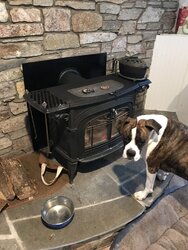Hello all,
I have a Vermont Castings Encore 2550. It is not one of the new flex burn models. I replaced the CAT less than two years ago and based on the smoke coming from my chimney and what happens when I reload the stove, I don’t think it’s working correctly...
I’ll start with the reloading. As per manual I will wait until I have only enough coals to reload before opening the damper and air and filling the stove. In the manual it recommends to rake the ash into the ash pan without breaking up the coals, which is more or less impossible. I have also heard people say the ash acts as an insulator for the coals and never to rake. Either way usually after I fill the stove and close the damper, I get a dramatic temperature loss. Usually when reloading the surface temp is 350 - 400. Even with the air temp all the way open, the temp will drop all the way down to 250 sometimes. I know I’m building a ton of creosote during this time and likely disengaging the CAT. Lately I have been keeping the damper open for a while after reloading and until the temp is back up past 500, but im worried it’s overfiring the stove. Also my burn times are barley 6 hours after reloading that way and it’s causing me to waste more wood and have to restart the fire all the time.
I tried watching the chimney to see the smoke change but to be honest there’s not much of a change until after the fire has burned up all the smoke anyway. I’m worried I need a new cat but it looks completely fine. No build up of ash in the honey combs or anything.
Grateful for any opinions...
I have a Vermont Castings Encore 2550. It is not one of the new flex burn models. I replaced the CAT less than two years ago and based on the smoke coming from my chimney and what happens when I reload the stove, I don’t think it’s working correctly...
I’ll start with the reloading. As per manual I will wait until I have only enough coals to reload before opening the damper and air and filling the stove. In the manual it recommends to rake the ash into the ash pan without breaking up the coals, which is more or less impossible. I have also heard people say the ash acts as an insulator for the coals and never to rake. Either way usually after I fill the stove and close the damper, I get a dramatic temperature loss. Usually when reloading the surface temp is 350 - 400. Even with the air temp all the way open, the temp will drop all the way down to 250 sometimes. I know I’m building a ton of creosote during this time and likely disengaging the CAT. Lately I have been keeping the damper open for a while after reloading and until the temp is back up past 500, but im worried it’s overfiring the stove. Also my burn times are barley 6 hours after reloading that way and it’s causing me to waste more wood and have to restart the fire all the time.
I tried watching the chimney to see the smoke change but to be honest there’s not much of a change until after the fire has burned up all the smoke anyway. I’m worried I need a new cat but it looks completely fine. No build up of ash in the honey combs or anything.
Grateful for any opinions...



